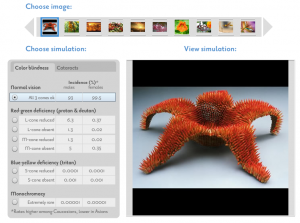Community Embraces New Word Game at Mid-Year Play Day This past Sunday, families at Takoma Park’s Seventh Annual Mid-Year Play Day had the opportunity to experience OtherWordly for the first time. Our educational language game drew curious children and parents to our table throughout the afternoon. Words in Space Several children gathered around our iPads […]
Read moreCategory: Interactive experiences
Not everyone sees the world as you do
You can try the Color Vision tool yourself by selecting an image and choosing a color blindness or cataract simulation. In the process, you can gain an understanding of why it’s important to design web sites that are accessible to people with these vision problems.
Why it matters
Hundreds of millions of people have vision problems. Two primary vision problems are cataracts and color blindness. When a person has a cataract, the lens in his or her eye is no longer entirely transparent. Because aging is the most common risk factor for the condition, increased life expectancy has made cataracts the leading cause of blindness worldwide. (more…)
In 2008, IDEA conducted a study about online experiences. The report (download PDF here) outlines key findings from surveys that explored factors that drive online experience as expressed by the three different subject groups – nonprofit organizations and cities, web designers and firms, and the general public. (more…)
Art Gallery of Greater Victoria In summer 2008, IDEA collaborated with the Art Gallery of Greater Victoria on their Warhol: Larger than Life exhibition. Working with Jonathan Lathigee and curator Helen Delacretaz of the Winnipeg Art Gallery, IDEA helped adapt its interactive color-changer of Andy Warhol’s famous Marilyn Monroe silkscreens into a kiosk that visitors
Real-life experiments
July 1st, 2006 by IDEA
Adding depth to online learning through hands-on experiments. (more…)
Incorporating intuitive graphs provides visitors with new insights. (more…)
Imparting greater understanding through object manipulation. (more…)
Color coding
June 1st, 2006 by IDEA
Color coding can help visitors identify images, as well as provide context. (more…)
Views of data
June 1st, 2006 by IDEA
Reducing multidimensional data enables visitors to control what they see. (more…)


